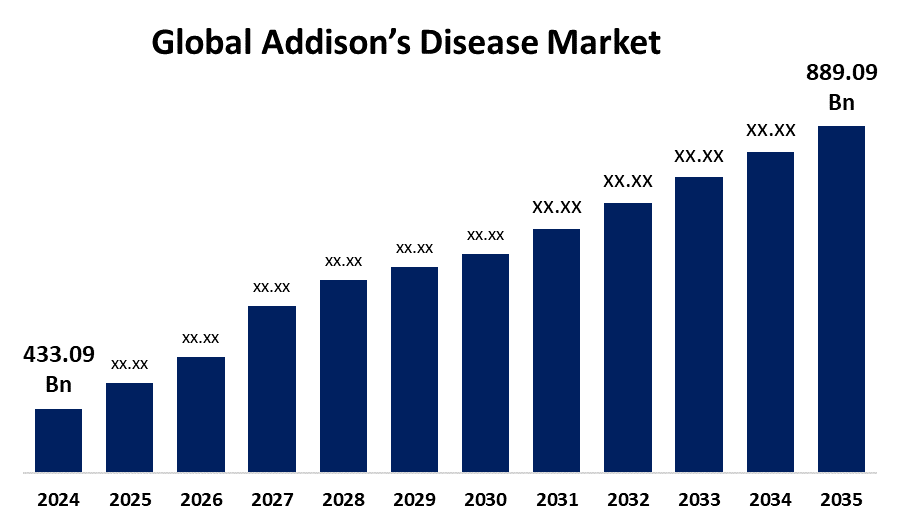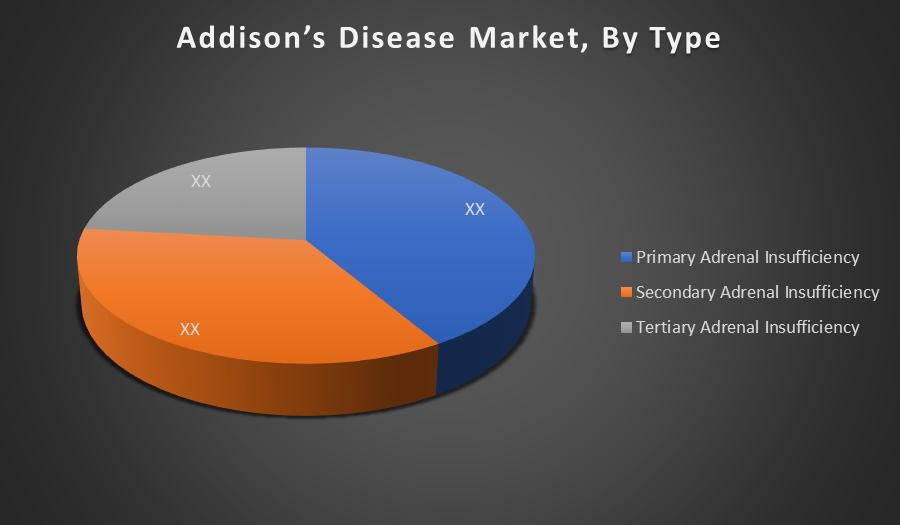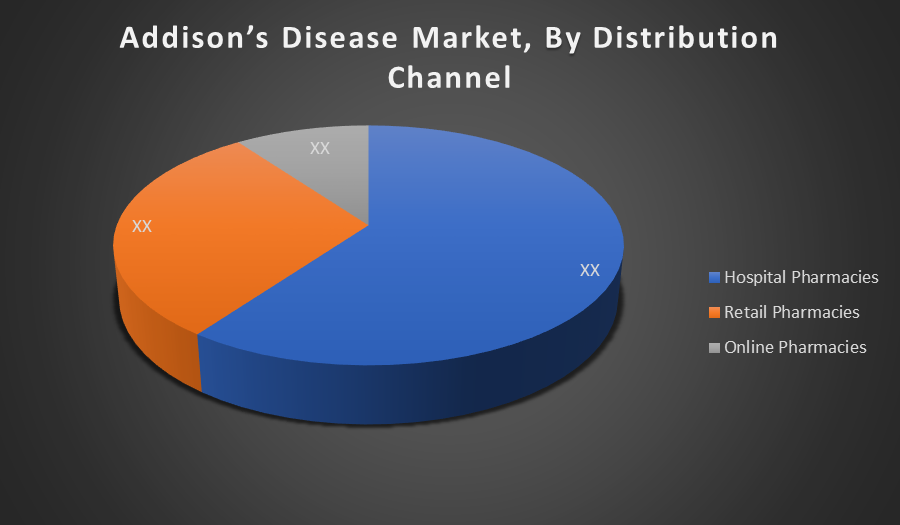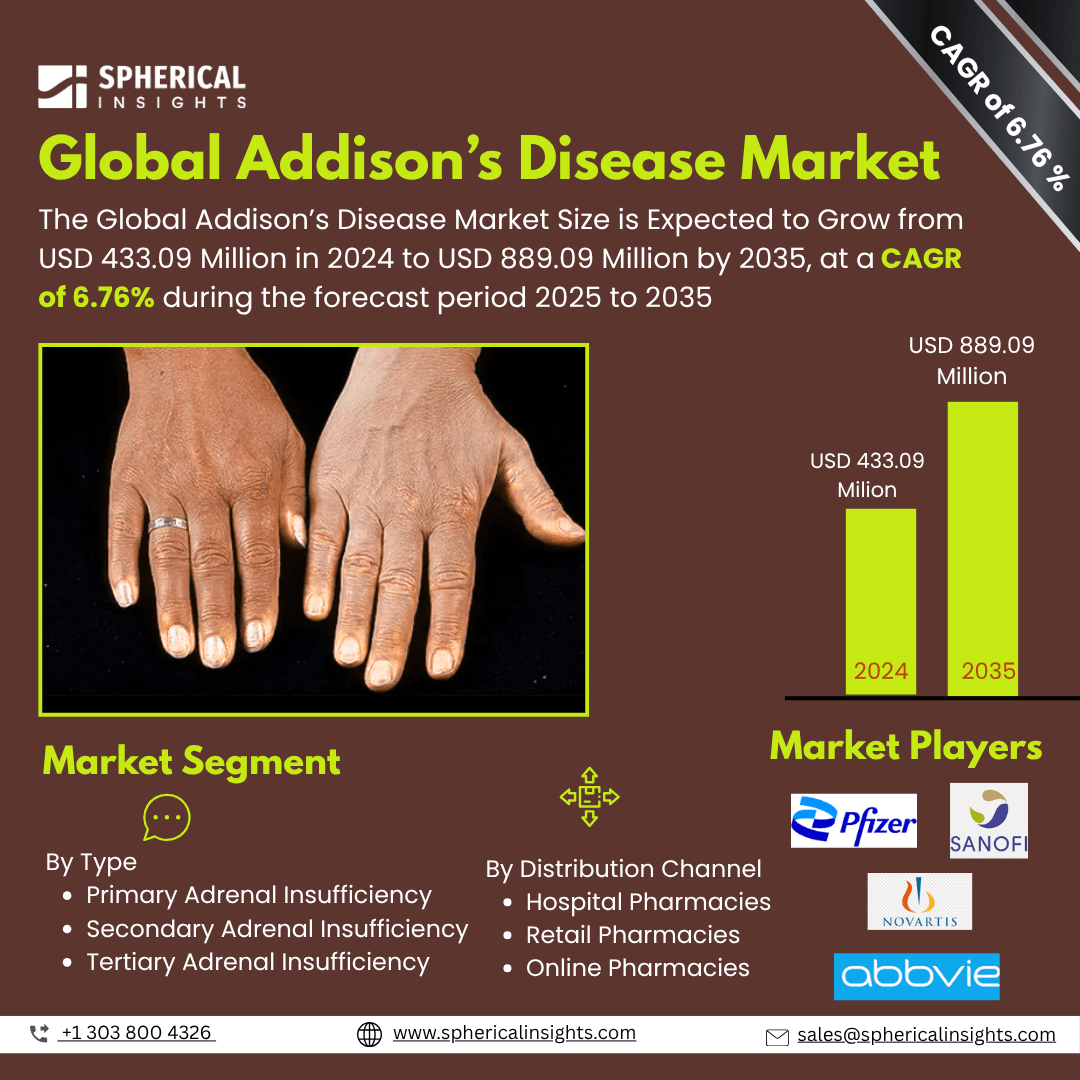- As per Spherical Insights & Consulting, The Global Addison’s Disease Market Size is Expected to Grow from USD 433.09 Million in 2024 to USD 889.09 Million by 2035, at a CAGR of 6.76% during the forecast period 2025 to 2035, owing to the launch of new therapies in the market and the rise in the number of cases.
- The leading Addison’s Disease Market Companies such as Pfizer, Bristol Myers Squibb, Sanofi, Novartis, Merck & Co., Takeda Pharmaceuticals, GlaxoSmithKline, Teva Pharmaceuticals, Bayer AG, Johnson & Johnson, AbbVie, Eli Lilly, AstraZeneca, Ferring Pharmaceuticals, Zydus Lifesciences, and Others.
Addison’s Disease Treatment Market: Understanding and Treatment Algorithm:
Addison’s disease is a rare autoimmune disorder in which the adrenal glands fail to produce enough cortisol and aldosterone. The immune system mistakenly attacks the adrenal cortex, leading to hormone deficiencies. Symptoms include fatigue, weight loss, low blood pressure, and skin darkening. Lifelong hormone replacement therapy is required.

Addison’s Disease Diagnosis:
Diagnosis of Addison’s disease involves evaluating symptoms and confirming hormone deficiencies through blood tests. Low cortisol levels alongside high ACTH levels indicate primary adrenal insufficiency. An ACTH stimulation test helps assess adrenal response. Imaging such as CT scans may be used to identify adrenal gland abnormalities or underlying causes.
Addison’s Disease Treatment:
Treatment of Addison’s disease focuses on lifelong hormone replacement therapy to restore deficient cortisol and aldosterone levels. Common medications include hydrocortisone or prednisone for cortisol replacement and fludrocortisone for aldosterone. During illness or stress, doses may need adjustment. Regular monitoring ensures symptom control and prevents adrenal crises.
Addison’s Disease Epidemiology
The disease epidemiology covered in the report provides historical as well as forecasted epidemiology segmented by Total Diagnosed Incident Population of Addison’s Disease, Gender specific Diagnosed Incidence of Addison’s Disease, Type specific Diagnosed Incidence of Addison’s Disease, Age specific Diagnosed Incidence of Addison’s Disease, Diagnosed Incident Population based on Primary Site of Addison’s Disease, and Diagnosed Incident Population based on Histologic Classification of Addison’s Disease Tumour in the global market covering North America, Europe, Asia Pacific, Latin America, the Middle East, and Africa from 2024 to 2035.
Principal Insights
This section offers a global overview of Addison’s disease epidemiology in major markets worldwide.
Country Wise- Addison’s Disease Multiforme Epidemiology
- The epidemiology segment provides Addison’s Disease prevalence data and findings across key regions worldwide, including North America, Europe (Germany, France, Italy, Spain, and the United Kingdom), Asia-Pacific (including Japan), Latin America, the Middle East, and Africa.
Addison’s Disease Recent Developments:
- In February 2025, Eton Pharmaceuticals announced that the U.S. FDA accepted its New Drug Application for ET 400, a room-temperature stable hydrocortisone oral solution developed for pediatric adrenal insufficiency. The announcement also noted the granting of a second U.S. patent, providing extended product exclusivity and strengthening the company’s pediatric endocrine portfolio.
Addison’s Disease Marketed Drugs:
Hydrocortisone is a synthetic corticosteroid that mimics natural cortisol and is used as a first-line replacement therapy in Addison’s disease. It helps regulate metabolism, immune response, and stress. Patients typically take it in divided doses to simulate natural hormone rhythms and prevent adrenal insufficiency symptoms.
- Fludrocortisone Acetate: Bristol Myers Squibb
Fludrocortisone is a mineralocorticoid used to replace aldosterone in patients with Addison’s disease. It helps maintain sodium balance, blood pressure, and fluid retention. It is usually prescribed alongside hydrocortisone to fully manage primary adrenal insufficiency, where aldosterone production is also impaired.
Prednisolone is a glucocorticoid used as an alternative to hydrocortisone in adrenal insufficiency management. It has a longer duration of action and may be preferred in certain patient populations for more stable hormone replacement, especially when compliance with multiple daily doses is challenging.
Addison’s Disease: Emerging Therapies
- Depot Tetracosactide (Synacthen): Depot tetracosactide is a long-acting synthetic ACTH (adrenocorticotropin) therapy under investigation to regenerate adrenal function. In clinical trials, it stimulated residual cortisol production in some autoimmune Addison’s patients, reviving adrenal activity and reducing dependence on external steroid replacement
- Rituximab Depot Tetracosactide Combination: This dual therapy combined B cell depletion (rituximab) with depot tetracosactide to promote adrenal regeneration. In early studies, over half of the participants showed increased endogenous cortisol synthesis, highlighting the potential for restoring partial adrenal function
- Stem Cell Based Regenerative Therapy: Preclinical development of mesenchymal and adipose derived stem cells aims to rebuild adrenal cortex tissue. These regenerative approaches could eventually restore cortisol and aldosterone production, offering a curative alternative to lifelong steroid therapy
- Dual Acting Glucocorticoid Formulations: Innovative sustained release and dual acting glucocorticoid formulations are in development to mimic natural cortisol circadian rhythm more closely. These aim to improve disease control and adherence while reducing side effects through more stable hormone levels
Addison’s Disease Market Outlook
- The Addison’s disease market comprises diagnosis, treatment, and management solutions for adrenal insufficiency caused by damage or dysfunction of the adrenal glands. It includes corticosteroid drugs, emerging regenerative therapies, and related diagnostic tools, targeting patients with primary, secondary, and tertiary adrenal insufficiency across various healthcare settings.
- Rising awareness of adrenal disorders, advancements in diagnostic testing, and the availability of effective corticosteroid treatments are key drivers. The increasing prevalence of autoimmune diseases and improved access to healthcare services also support growth, especially in developed countries with structured chronic disease management programs.
- Emerging regenerative therapies, adrenal function–restoring research, and the development of sustained-release hormone formulations offer new opportunities. Growth in telemedicine, digital prescriptions, and expanding healthcare infrastructure in developing regions also creates untapped potential for improving diagnosis, adherence, and long-term care in Addison’s disease management.
- Governments and public health agencies support rare disease research, improve corticosteroid accessibility, and fund adrenal insufficiency education programs. Global rare disease registries, subsidies for orphan drugs, and faster regulatory approvals are promoting innovation and equitable treatment access in this rare endocrine disorder.
- Lack of curative treatment and dependence on lifelong steroid therapy limit innovation and long-term patient outcomes.
- The market is projected to grow steadily due to rising diagnosis rates, increasing autoimmune prevalence, and advancements in replacement therapies.
Addison’s Disease Market Segmentation
By Type:
- Primary Adrenal Insufficiency
- Secondary Adrenal Insufficiency
- Tertiary Adrenal Insufficiency

Primary Adrenal Insufficiency holds the largest share in the Addison’s disease market due to its higher prevalence and well-established diagnostic and treatment pathways. Increased awareness, early detection, and a higher incidence of autoimmune disorders contribute to the dominance of this segment in both developed and developing regions.
By Distribution Channel:
- Hospital Pharmacies
- Retail Pharmacies
- Online Pharmacies

Hospital Pharmacies hold the largest share in the Addison’s disease market due to the critical nature of hormone therapy and the need for accurate dosing and monitoring. Patients often initiate treatment in hospital settings where specialist care, immediate access to medication, and follow-up services are readily available.
Regional Segment Analysis of the Addison’s Disease Market
North America holds the largest share in the Addison’s disease market due to advanced healthcare infrastructure, high awareness levels, and strong availability of diagnostic tools and hormone replacement therapies. The presence of major pharmaceutical companies and supportive regulatory bodies further enhances treatment access. Regular screening practices and robust insurance coverage enable early diagnosis and long-term management, making the region a key contributor to overall market demand and revenue generation.
Asia-Pacific is the fastest-growing region in the Addison’s disease market, driven by increasing healthcare investments, improving diagnostic capabilities, and growing public awareness. Countries like India, China, and Japan are experiencing better access to specialty care and rising prevalence of adrenal insufficiency. Expanding pharmaceutical distribution networks and government-led healthcare reforms are also accelerating treatment adoption, positioning the region as a dynamic and promising area for future market expansion.
Addison’s Disease Market Key Companies
- Pfizer
- Bristol Myers Squibb
- Sanofi
- Novartis
- Merck & Co.
- Takeda Pharmaceuticals
- GlaxoSmithKline
- Teva Pharmaceuticals
- Bayer AG
- Johnson & Johnson
- AbbVie
- Eli Lilly
- AstraZeneca
- Ferring Pharmaceuticals
- Zydus Lifesciences
- Others
Addison’s Disease Therapeutics Market Report Scope
- The Addison’s Disease therapeutics market report provides a detailed overview, covering its causes, symptoms, disease progression, and existing treatment options.
- Detailed insights into Addison’s Disease’s epidemiology and therapeutic approaches are included.
- Additionally, a comprehensive review of existing and emerging Addison’s Disease therapies is provided, including an evaluation of new treatments expected to influence the current Addison’s Disease treatment market landscape.
- The report includes a detailed review of the Addison’s Disease therapeutics market, both historical and forecasted, highlighting the global drug reach.
- The Patient-Based Addison’s Disease Market Forecasting report offers valuable insights into trends shaping the global Addison’s Disease market, helping to develop effective business strategies.
Addison’s Disease Treatment Market Report Insights
- Forecasting Market Trends Based on Patient Data and Disease Rates
- Addison’s Disease Therapeutic Approaches in Addison’s Disease
- Review Of Drugs in Development for Addison’s Disease
- Market, Growth, and Trends in Addison’s Disease
- Market Opportunities in Addison’s Disease Treatment
- Effects Of Future Therapies on Addison’s Disease Treatment.
Addison’s Disease Treatment Market Report Key Strengths
- 15 Years Addison’s Disease Market Forecast
- Global Coverage
- Addison’s Disease Epidemiology Segmentation
- Key Cross Competition
Addison’s Disease Treatment Market Report Assessment
- Present Practices in the Addison’s Disease Treatment Market
- Review of Investigational Addison’s Disease Drugs
- Attractiveness of the Addison’s Disease Drug Market
- Addison’s Disease Market Drivers
- Addison’s Disease Market Barriers
- SWOT
- Attribute Analysis
Market Segment
This study forecasts revenue at the global, regional, and country levels from 2020 to 2035. Spherical Insights has segmented the Addison’s Disease market based on the below-mentioned segments:
Global Addison’s Disease Market, By Type
- Primary Adrenal Insufficiency
- Secondary Adrenal Insufficiency
- Tertiary Adrenal Insufficiency
Global Addison’s Disease Market, By Distribution Channel
- Hospital Pharmacies
- Retail Pharmacies
- Online Pharmacies
Global Addison’s Disease Market, By Regional Analysis
- North America
- Europe
- Germany
- UK
- France
- Italy
- Spain
- Russia
- Rest of Europe
- Asia Pacific
- China
- Japan
- India
- South Korea
- Australia
- Rest of Asia Pacific
- South America
- Brazil
- Argentina
- Rest of South America
- Middle East & Africa
- UAE
- Saudi Arabia
- Qatar
- South Africa
- Rest of the Middle East & Africa






